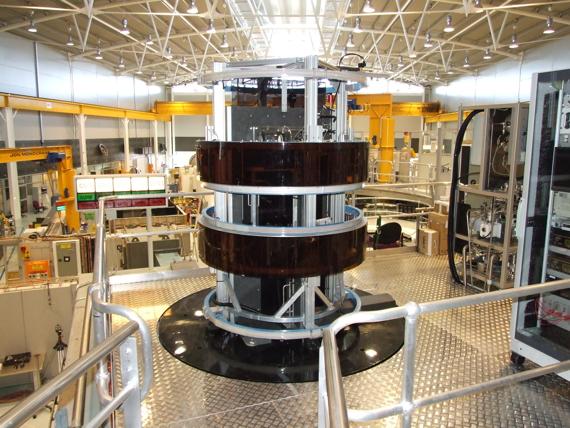

Infrastructure - Magnetism
Neutron scattering instruments
To name just some of the principal experiments, magnetic structures can be determined from powder samples on ECHIDNA and WOMBAT, from single-crystal samples on KOALA, KOWARI and WOMBAT, and from epitaxial samples on TAIPAN, magnetic excitations can be traced in single-crystal samples on TAIPAN and SIKA or in powder samples on PELICAN, flux-line lattices and magnetic correlation lengths can be studied on QUOKKA and BILBY, and magnetic depth profiles in thin-film structures determined by reflectometry on PLATYPUS and SPATZ.
Polarised neutrons

The 3He polarising station atop the guide bunker
The sensitivity of neutron scattering to magnetism can be considerably enhanced if the incident neutron beam is polarised, i.e. the neutron spins are all aligned parallel. One application amongst many is the study of the distribution of unpaired electrons around a magnetic atom, by direct determination of the spin density by the flipping-ratio technique using single crystals. The experimental observations are analysed using methods similar to those for X-ray charge density.
Sample environment
Magnetism in the increasingly more complex materials of interest imposes severe demands on the neutron experiment. It is rare that magnetism can be observed or characterised correctly under ambient conditions. Molecular compounds that order magnetically in three dimensions, often only do so at very low temperatures. The suite of available cryostats is growing with the possibility to provide temperatures routinely down to 0.25 K on most instruments.
To study the magnetism in those materials that do not order spontaneously requires cryomagnets, either to investigate metamagnetic transitions, or to determine the distribution of spin density. Both vertical-field and horizontal-field cryomagnets are available, although their sizes do limit where they may be used. Pressure is another useful variable since the magnetic behaviour is closely linked to the atomic bond lengths. Click here for the current list of available sample environments.
Magnetometry
Complementary property measurements are essential to guide the strategy of the neutron experiment. A vibrating-sample magnetometer is available at ANSTO for collaborative projects and radioactive samples.
Modelling
Some modelling support for magnetic studies is available. For more information, contact Magnetism project member working in your research area.